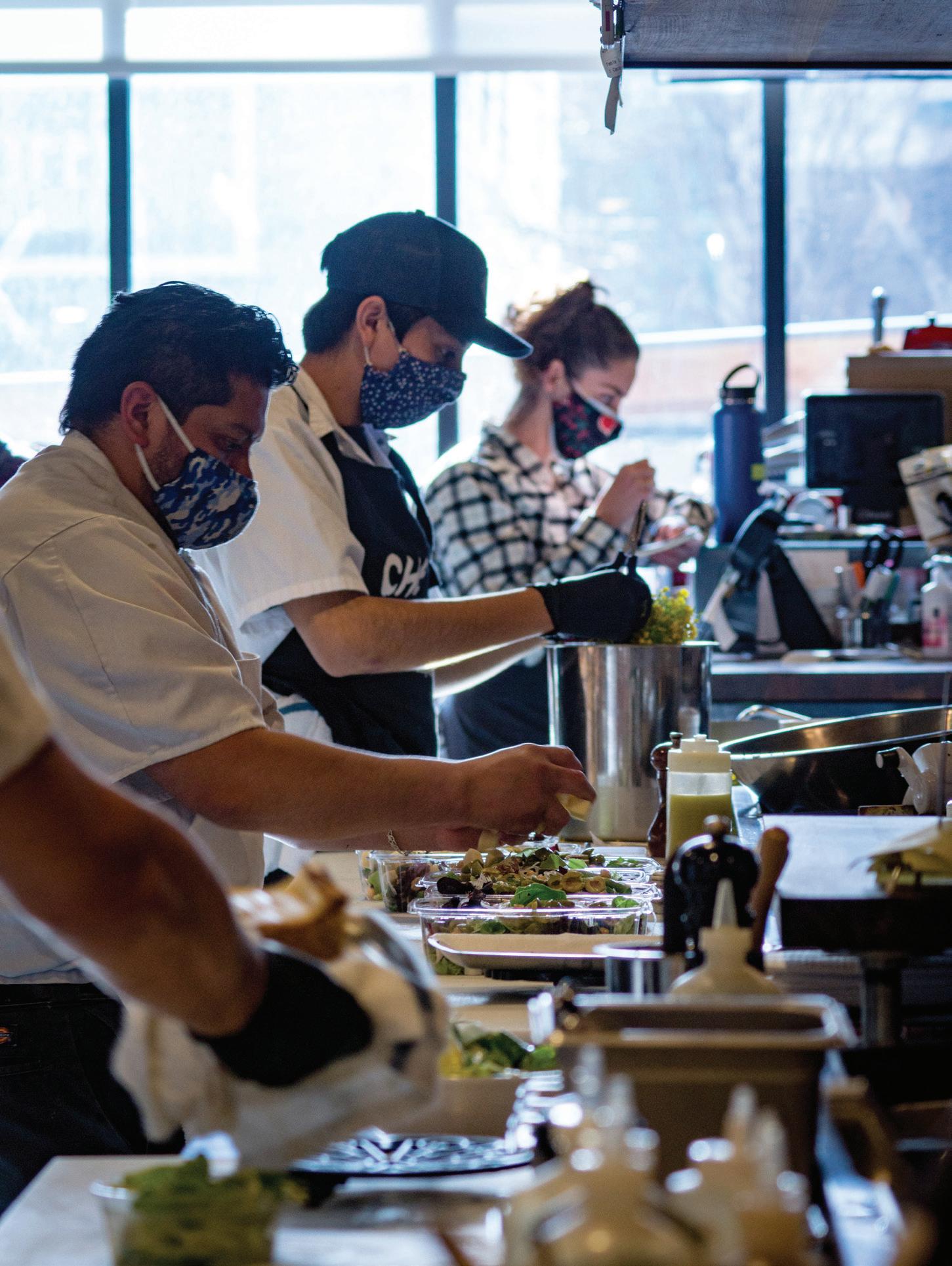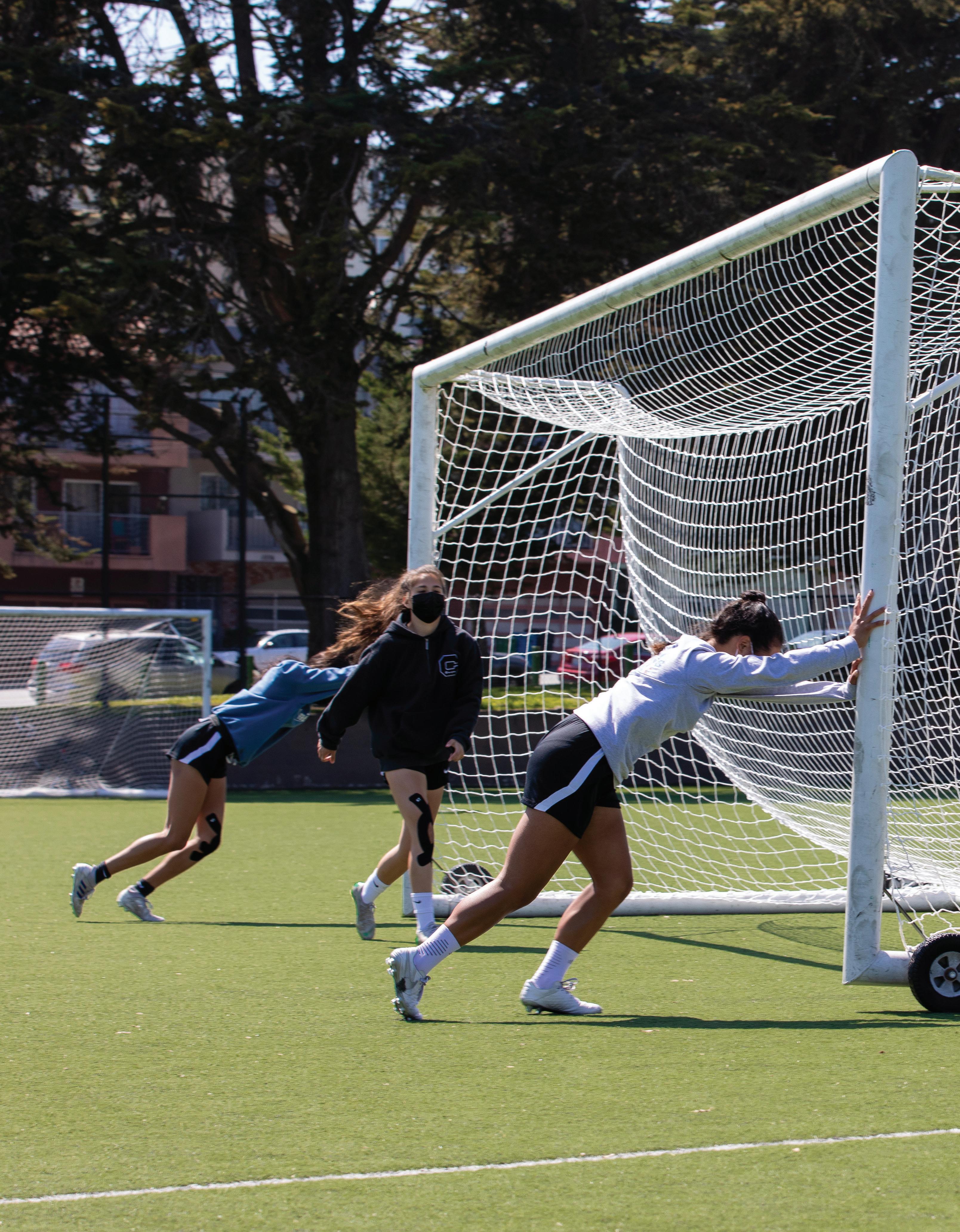
34 minute read
Are You Game?
ARE
16 Etc Magazine YOU GAME?
Advertisement
City College soccer players, from right to left, Aida Pedemonte, Gabriela Rodil, and Maleah Evans push a goalpost into position for their scrimmage game.
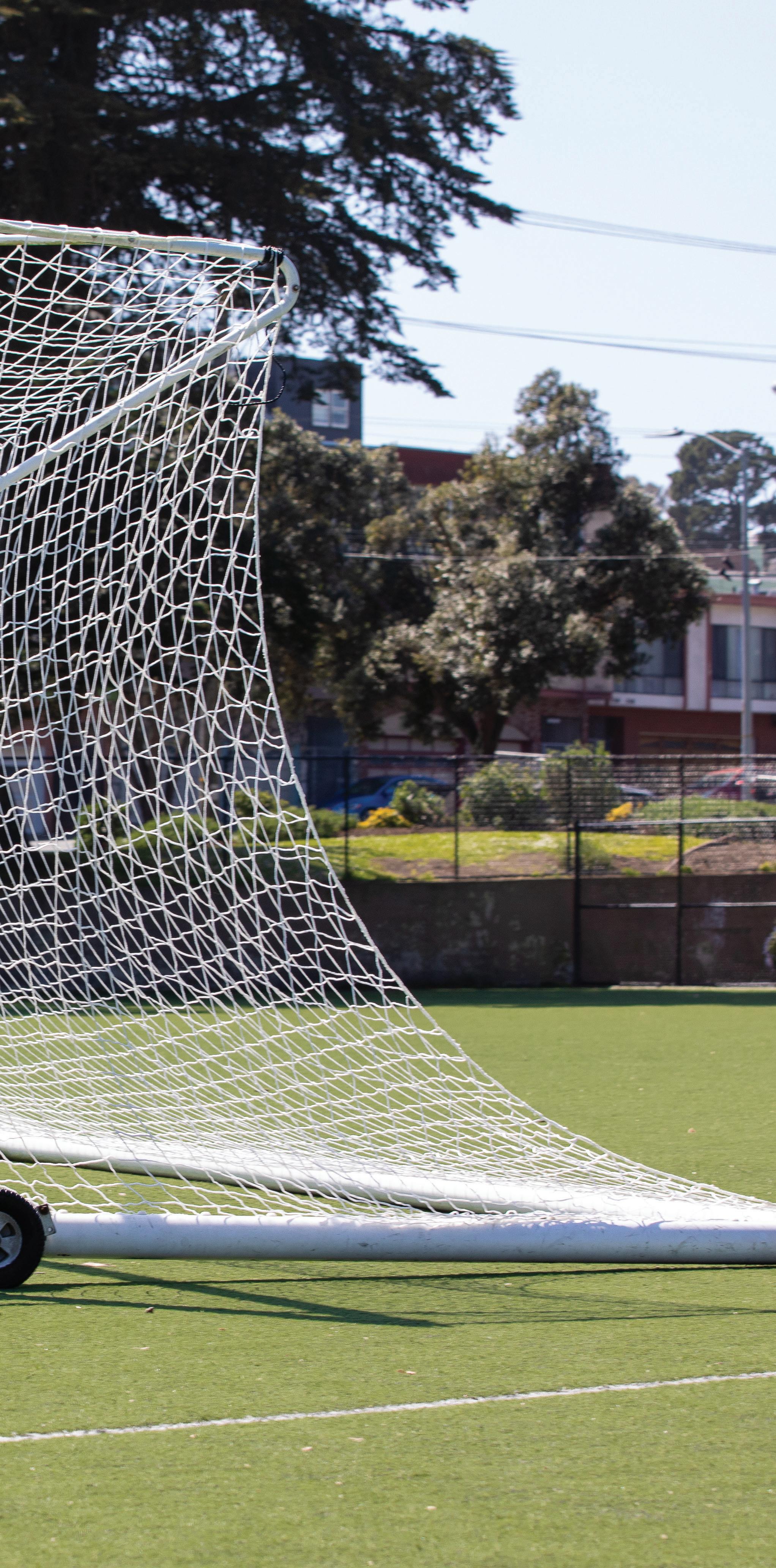
City College gets back on the field
Story and photography by Melvin Wong
Sports fans: Get ready. The athletics program at City College of San Francisco officially resumed after a year of pandemic shutdowns this spring. Under strict COVID-19 regulations, three out of the four men’s teams, and six out of the seven women’s teams have begun practice. While some City College teams have chosen not to compete this year, the water polo, soccer and tennis teams have agreed to scrimmage with other schools’ teams.
The National Collegiate Athletic Association, NCAA, has determined that all of the 2020 and 2021 sport seasons will not be counted toward any student athlete’s eligibility. Eligibility is the NCAA ruling that gives each student athlete five calendar years to play in at least four eligibility seasons. This timeline begins at their initial enrollment at any college.
In spite of having been benched for an entire year due to the pandemic, a few City College rising stars have caught their coaches’ eyes. They are excited and prepared to get back on the field. Their coaches anticipate they will thrive in their sports careers.
They want to make the most of their college careers, but the chances of a student athlete extending their game past the college level are slim. For example, the probability of playing professionally ranges from 9.9% of college baseball players to just 0.8% in women’s basketball according to the NCAA website.
Successful college athletes, whether they become professionals or not, often have certain qualities in common. They tolerate criticism, foster a strong work ethic, and genuinely love what they do. Take note of each of the players below as their athletic prowess potentially takes them to play at four-year colleges and possibly into the professional sports industry.
BASKETBALL MIKAYLA AMOROSO
Mikayla Amoroso gets out of her friend’s black BMW and heads to the outdoor basketball courts behind St. Stephen’s Catholic School to coach. There has been an increased demand for enrollment in the Bay City basketball program because of the public school shutdowns, so they split the girl’s camp into two cohort teams. Amoroso coaches the 2nd to 4th grade “select” team and the other coaches oversee the “practice” team.
Many of the girls arrived early and are already shooting baskets when Amoroso walks in. She drops her backpack down, calls her team to line up on the court’s baseline and begins a running drill. She first explains then executes an example of what she wants the team to do. As each girl performs the drill, she critiques their form, offering instructions on the nuances of their arm and leg movements.
The girls are full of energy. They constantly ask Amoroso questions and try their best to perform each drill. Amoroso calls a quick thirty-second water break before they start back up again. She assigns pushups or running laps for repeated errors. The hour and fifteen minutes fly by due to the high tempo, non-stop pace of the practice session. She enjoys coaching because it allows her “to see the game in a different way” and challenges her to understand the “frustration of trying to get through to a player and find the right words.”
Basketball is still a male-dominated sport, but Amoroso hopes to change that narrative. Girls tend to drop the sport when they reach around ten- or twelveyears old, and most do not continue playing into high school. Amoroso believes negative attitudes on social media about women basketball players have influenced these impressionable minds. She hopes that by being a good role model, she can show them otherwise.
Amoroso is a City College sophomore who missed the opportunity to play in her freshman 2019-2020 season because of the pandemic shutdown. She is excited for her first game as a Ram in this condensed and unofficial 2021 spring season. The season consists of scheduled scrimmages with official referees against other Bay Area community colleges.
Amoroso was born and raised in San Francisco. Her Italian father stressed the importance of getting good grades in school, while her Chinese mother has always been an advocate for women in sports. She would drive Amoroso to all of her basketball practices and games.
Amoroso has played basketball since kindergarten at the Saint Vincent De Paul School. She has played in the Asian League, in club basketball at Bay City, and throughout high school.
Tim Kees, Amoroso’s longtime Bay City coach, started working with her five years ago. He currently coaches the girl’s varsity basketball team at Gateway High School in San Francisco. Coach Kees says Amoroso’s biggest strength is her “basketball I.Q. and decision making. “She’s been playing for a long time, so she’s seen enough of the game to pick up the patterns quickly,”
Amoroso finds basketball to be a useful distraction when life off the court gets difficult. When she was in middle school, her older sister Amanda was diagnosed with a rare form of kidney cancer, and under the stress, Amoroso’s parents separated. During this period twelve-year old Amoroso learned how basketball could serve as a stress relief through hard times. Amanda eventually made a full recovery.
Basketball was always there for Amoroso until she suffered a potentially careerending injury, a torn left lateral meniscus with resulting cartilage lesions. This type of injury completely immobilizes the knee, and the recovery process sidelined her for six months.
The injury tested her love for the game. “Do I want to put myself through all this pain to go back to it?” she wondered. But she missed the camaraderie between her teammates and the happiness she felt at practice. “This is what I’m meant to do,” she says.
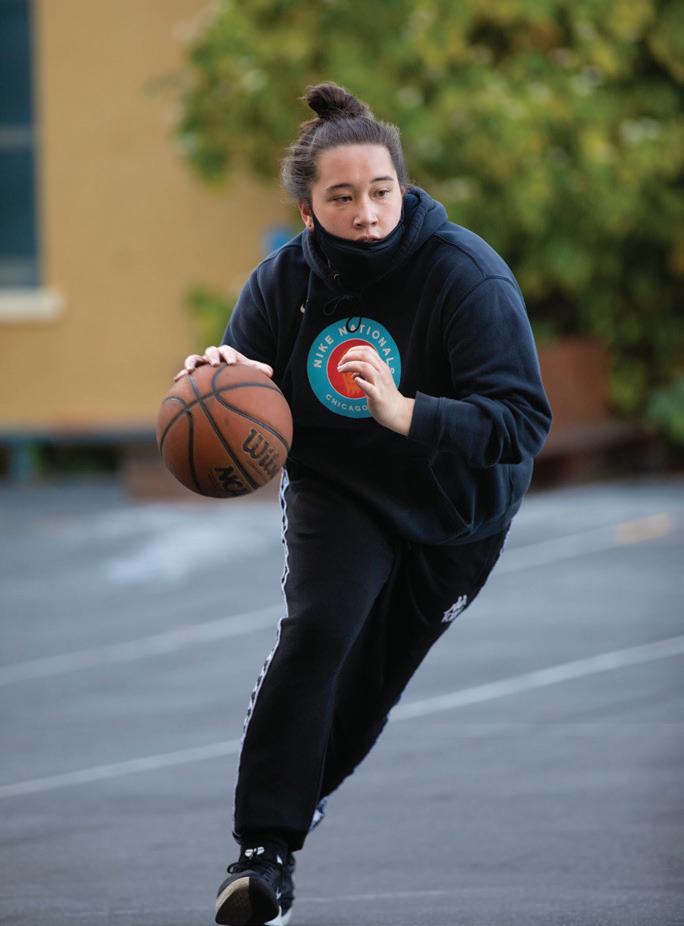
Mikayla Amoroso drives toward the basket at the Gateway High School’s outdoor courts.
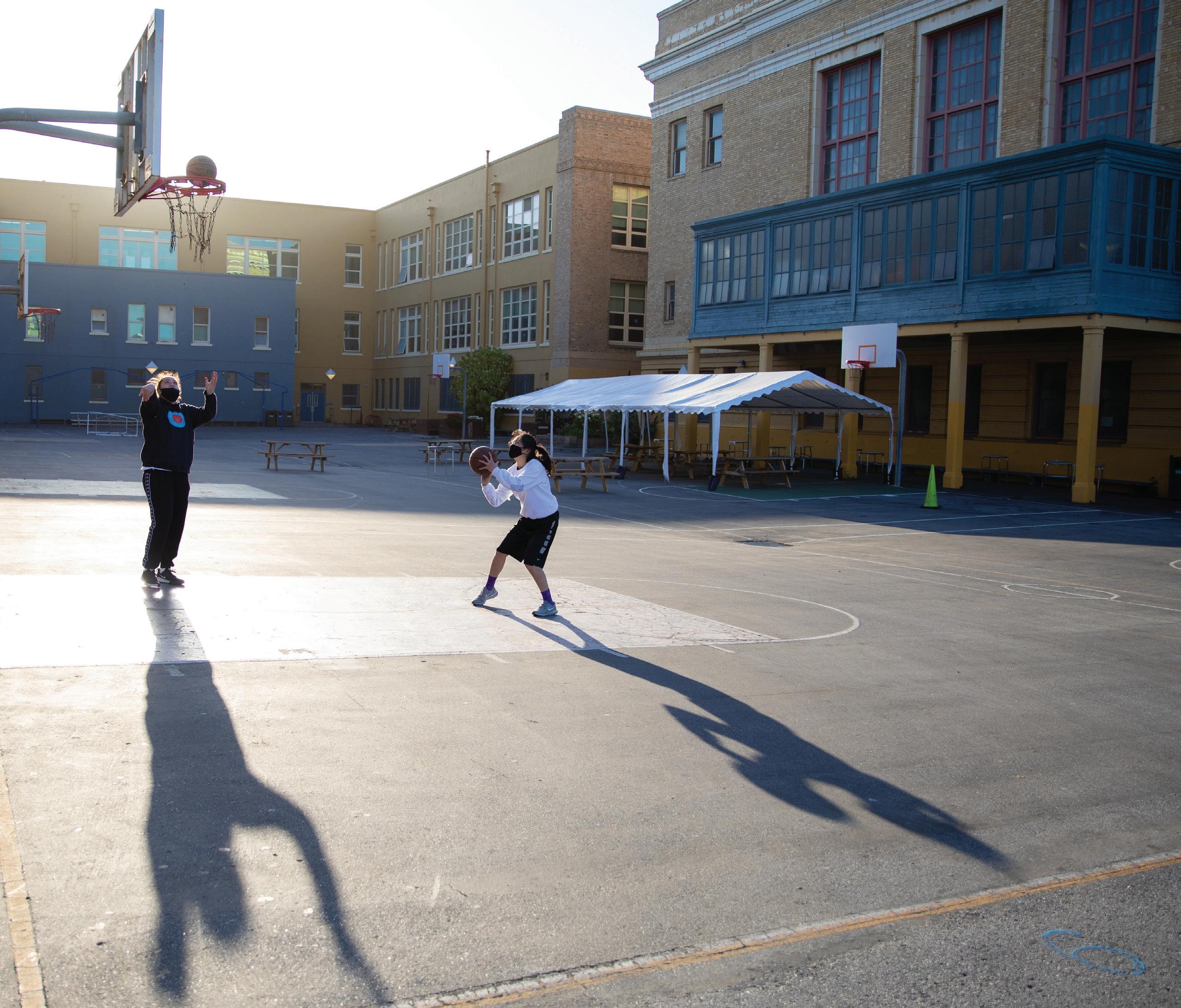
Amoroso and her cousin Keira Wong shoot baskets before a late afternoon practice with Coach Tim Kees at Gateway High School.
Amoroso’s injury serendipitously coincided with the pandemic shutdown, so she was able to undergo rigorous physical therapy to relearn how to move her knee again just in time to be at nearly full strength by the start of the 2021 season. But her road to recovery was difficult. She had to look inward to encourage herself “to get better and be better.”
Amoroso finishes coaching the girls and walks to her mom’s car, which is waiting to take Amoroso to her own basketball practice. Due to the safety guidelines at City College, unauthorized entry into campus is restricted, so Amoroso reaches out to Coach Kees for additional practice.
Coach Kees opens the gate entrance as the gusting winds howl throughout the empty outdoor basketball courts at Gateway High School. Amoroso is joined by her younger cousin, Kiera Wong. They walk in together, drop off their bags and begin shooting the ball around. It is cold outside and the steam from their breath fills the air as the last rays of sunlight disappear behind the school building.
Coach Kees reviews the fundamentals. He goes over shooting technique, feet placement, and ball handling. The explanation for each following drill is thorough. As Amoroso and Wong go through the exercises, every misstep is critiqued and corrected.
The final layup drill tests Amoroso’s speed as Coach Kees defends her. She grips the ball next to her right hip. She then explodes to the basket, takes two dribbles, and hesitates her third. The forward momentum jerks Coach Kees away from Amoroso, and this creates just enough space for her to correctly set her feet, jump, and make the shot.
“This kid is extremely skilled,” says Coach Kees. “She’s really good at basketball and off the court, a great person all the way around.”
BASEBALL BRETT TAKUCHI
Brett Takuchi grabs his bat and helmet, hops into an Uber and heads for an indoor batting cage. With the City College 2021 unofficial baseball season off to a late start, he plans to hit a few balls and work on his swing. Baseball is largely a muscle-memory sport, and his arms are rusty.
The unassuming office building exterior of Future Pro Baseball Center in Burlingame, Calif. gives way to the threelaned indoor batting cage and a large Astroturf practice field. Takuchi greets the owner Ray Evangelista with a fist bump and settles in for his first of six rounds with the machine. Each round throws twenty pitches.
High intensity music plays in the background and the fluorescent lights illuminate Takuchi’s batting lane. The pitching machine behind the black curtain clunks and groans before spitting out the first pitch.
Takuchi bunts the first round to warm up. He does not consider himself a “power hitter” who can simply knock every ball out of the park, so he works on his precision instead. He visually sections off three hitting zones, left, middle and center, and then focuses hitting a different zone each round. Later he tries to hit the back wall at certain heights.
He finishes his session and returns the bat and helmet, which were borrowed from the shop. He begins to pull out his wallet to pay for his eight-round session, two more than he initially set out for, but Evangelista interrupts him with a request. Antonio, Evangelista’s son, was recently cut from his junior varsity high school baseball team, so Evangelista asks Takuchi to share his perspective. Takuchi listens to Antonio whose coaches deemed him “not strong enough.” Takuchi has heard a similar story before—his own.
Antonio believes he has been overlooked by the coaches based on his modest size. He thinks they may have a bias against Asian-American players. Antonio is of Filipino and Japanese descent. Takuchi and Antonio’s father listen and nod in agreement.
Takuchi has experienced the same kind of treatment. “I’m not saying all coaches look down on Asian players, but a lot do,” he says. He considers baseball to be an American pastime and believes that the teams should be diverse so fans can relate to the players.
Takuchi is a fourth-year San Francisco State University, SFSU, student that got passed up by the SFSU team in his freshman year and again in his sophomore year before finally joining the baseball team at City College. Mario Menendez, City College’s head baseball coach, scouted Takuchi at an SFSU practice and convinced him to join the team at City College. Takuchi joined the team during the spring 2019 season, but did not have the chance to play because of the pandemic.
He grew up around Torrance, California in a sports-oriented family. He has a twin brother, Kyle, and a younger brother, Todd. His father, Craig Takuchi, was his first baseball coach and mentor. He believed Takuchi had potential but wasn’t realizing it yet, so he was very hard on him.
Takuchi’s best childhood friend, Taishi Nakawake, plays Division I baseball at the University of California, Irvine. Takuchi admires Nakawake. “A little bit of my work ethic comes from him. … just seeing how hard he works, and me striving to be where he’s at,” Takuchi says.
Takuchi stands at 5 foot 6 inches which is considered short for a baseball player, but he makes up for his size by outworking his peers. “The hard work after practice, getting enough food, getting enough sleep, doing your work to stay eligible … I’m a firm believer that if you do all that … the results will come,” he says.
At the batting cage, Evangelista rewraps a new grip on a returned bat and hands it to Takuchi as a thank you for speaking with his son. Evangelista has nothing but praise for Takuchi. “He’s a great kid, a hard worker, very focused, and a leader.” He asks Takuchi if he would be interested in working as a baseball trainer for Antonio. Evangelista hopes Takuchi’s work ethic and leadership skills can rub off on his own son. Takuchi finishes up his routine at home as he rolls out his yoga mat and takes out his workout bands. Even after a long day of batting practice, the hard work does not end and neither does Takuchi’s tenacity for his sport.
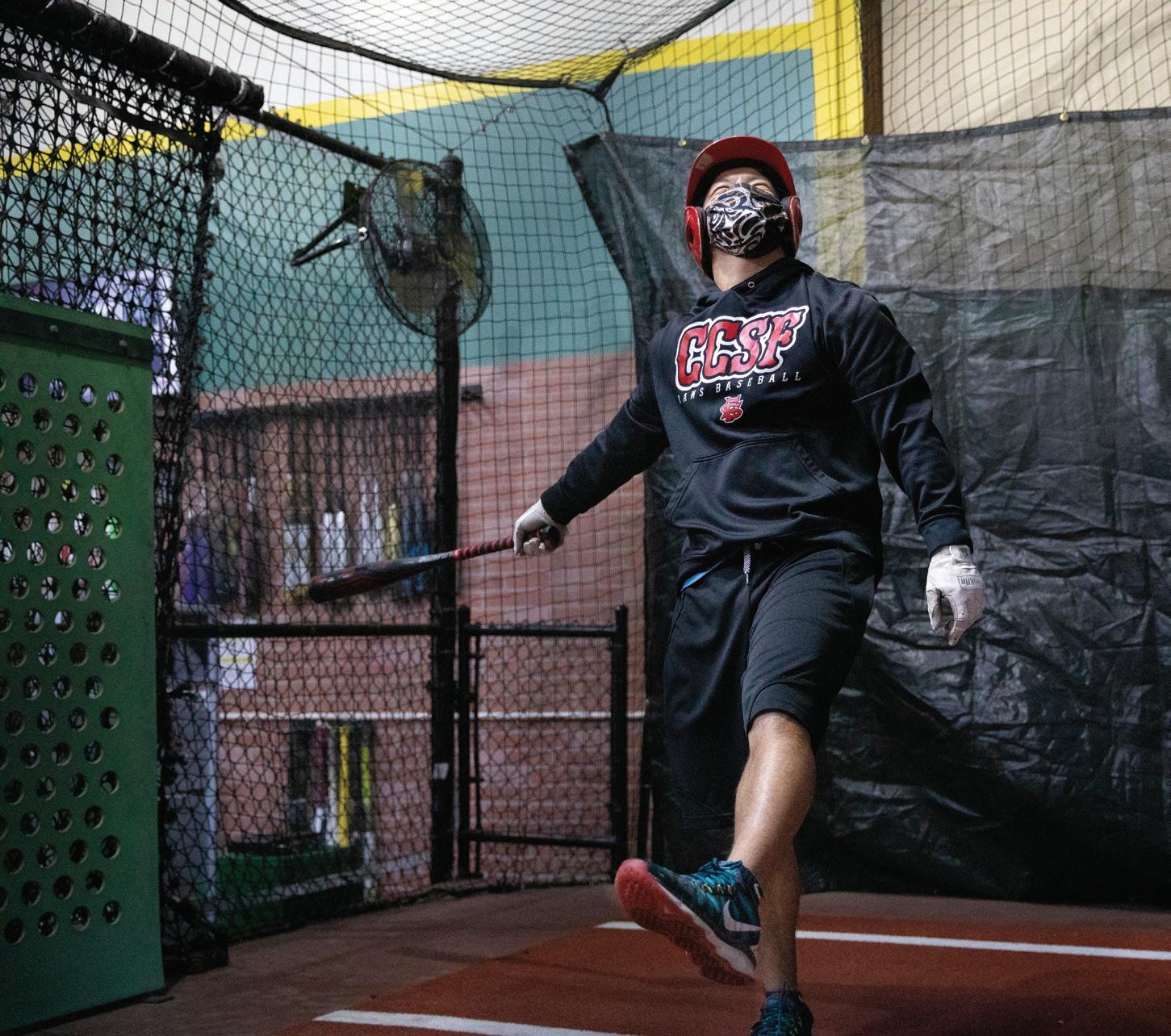
FOOTBALL DINO KAHAULELIO
Dino Kahaulelio walks toward the chain link fence that surrounds the Elsie Allen High School’s football field near his home in Santa Rosa. A few of his City College Rams football teammates are with him. “People fix and tear down this fence all the time,” he says as they hopped over a broken section.
Kahaulelio was the team captain for the football team during the fall 2019 football season, before the pandemic shuttered the 2020 fall season.
Kahaulelio is large and muscular with long curly hair sticking out from under a fitted ball cap. He is of Hawaiian descent and proud of his heritage. On his left arm he has a traditional Hawaiian tattoo of his family name and tribe.
He is a journalism major and wants to use his degree to write about his Hawaiian roots. “Not many people know the truth about our culture,” he says. “So being a journalist, that gives me the chance to help teach others what it is.”
On the field, while his teammates warm up, Kahaulelio sets out small cones. Some of his teammates mumble about the drill he wants them to do, but Kahaulelio, a natural born leader, is persuasive. He insists it is a good training exercise.
He hopes to continue his football career after City College. He says he will go anywhere that offers him a scholarship, “so I don’t have to put any burden on my family with cost and tuition.” After practice he and his teammates go back to his place to hang out. He lives on a large piece of farmland with several structures behind the main house, including a family-built batting cage and an old barn-like building which works as his gym and bachelor pad.
The walls of the gym are decorated with Hawaiian memorabilia, signs, plaques, and a gigantic banner displaying his high school football team. There is a squat bar that he and his uncle built together, a TV area, and a kitchen. It is perfect for relaxing with his friends and working out.
He heads over to the batting cage to find his friends goofing around, hitting half-heartedly and casually throwing balls at each other. “Bro, let me show you how it’s done,” Kahaulelio says and grabs a bat.
After a while, Kahaulelio and his teammates head back to his gym. There is a short struggle over the best couch spots as the football players settle in and watch an episode of “The Office.”
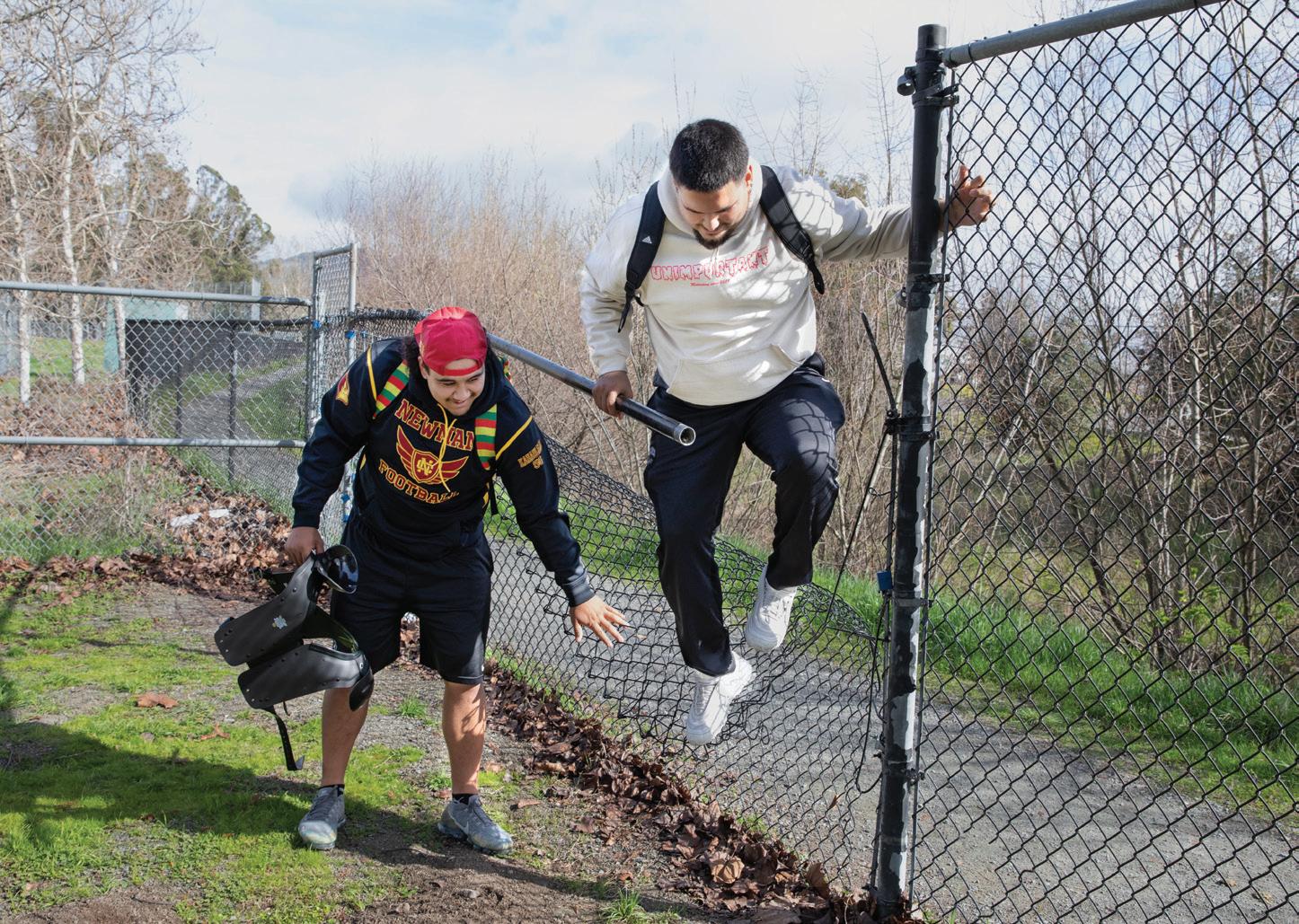
Teammates Dino Kahaulelio, left, and Isaias Sierra, right, jump the fence that surrounds the Elsie Allen High School’s football field near his home in Santa Rosa, Calif. They like to use the field for practice.

SOCCER AIDA DYDASCO PEDEMONTE
Aida-Rose Kapua Auli’i Dydasco Pedemonte walks onto the Crocker Amazon soccer fields with her cleats strung over her shoulder and a large Hydro Flask water bottle sticking out of her gym bag. The entire City College campus is closed for spring break, so Dydasco Pedemonte and her fellow captains are hosting a team practice to prepare for an upcoming scrimmage against the West Valley Vikings in Saratoga, California.
Dydasco Pedemonte greets her teammates with a smile behind her mask and a friendly wave. The players chat while they change shoes and tie up their hair. Fist bumps and laughter fill the air. They begin stretching and focus especially on warming up their legs.
A few players jog over to the far side of the field to push the moveable goalpost into position. Dydasco Pedemonte places orange cone markers for their first passing drill.
She hands out neon green practice jerseys to her teammates. “We better win!” she says jokingly to her teammates. Her competitive spirit peeks through even in jest.
A City College sophomore, Dydasco Pedemonte is playing in her second year on the women’s soccer team. So far though, she has played just one season—fall 2019. The 2020 season shut down due to COVID-19. In this 2021 unofficial season, they play weekly scrimmages with a small selection of other Bay Area colleges.
Soccer is and has been a constant in Dydasco Pedemonte’s life since she started playing in elementary school. Her parents both played soccer at San Francisco State University. Her older sister Olajua played soccer at Point Park University in Pittsburg, Pennsylvania, and her younger brother Eduardo currently plays on the South San Francisco High School soccer team.
She says soccer gives her life structure, and she feels challenged every time she is on the field. “It mentally and emotionally pushes me past a point where I think I can’t do it or I’m really tired,” she says. She pushes through that point of exhaustion because she always wants to do better. “If not for myself, then for my team.”
She finds a way to balance the rigor of soccer and a part-time job as a waitress while she works toward a degree in psychology. Extremely goal-oriented, Dydasco Pedemonte plans on moving to Boston next year to attend Fisher University on a full soccer scholarship.
She plans to attend graduate school too, but her ultimate goal is “to be happy in life.” She believes focusing on things out of one’s control leads to unnecessary stress. “Being comfortable with the fact that you can’t control everything in your own life is really important,” she says.
Although soccer is a respected and beloved sport globally, Dydasco Pedemonte asserts that there is a general “lack of recognition” for women’s soccer worldwide, particularly in the United States. “Our women’s team has performed (inter)nationally better than the men’s team. … (The U.S. women’s national team) is underpaid, and they just get a lot less national recognition for their accomplishments,” she says.
She makes a good point. The U.S. women’s national team currently holds the 2019 World Cup title and has won four in
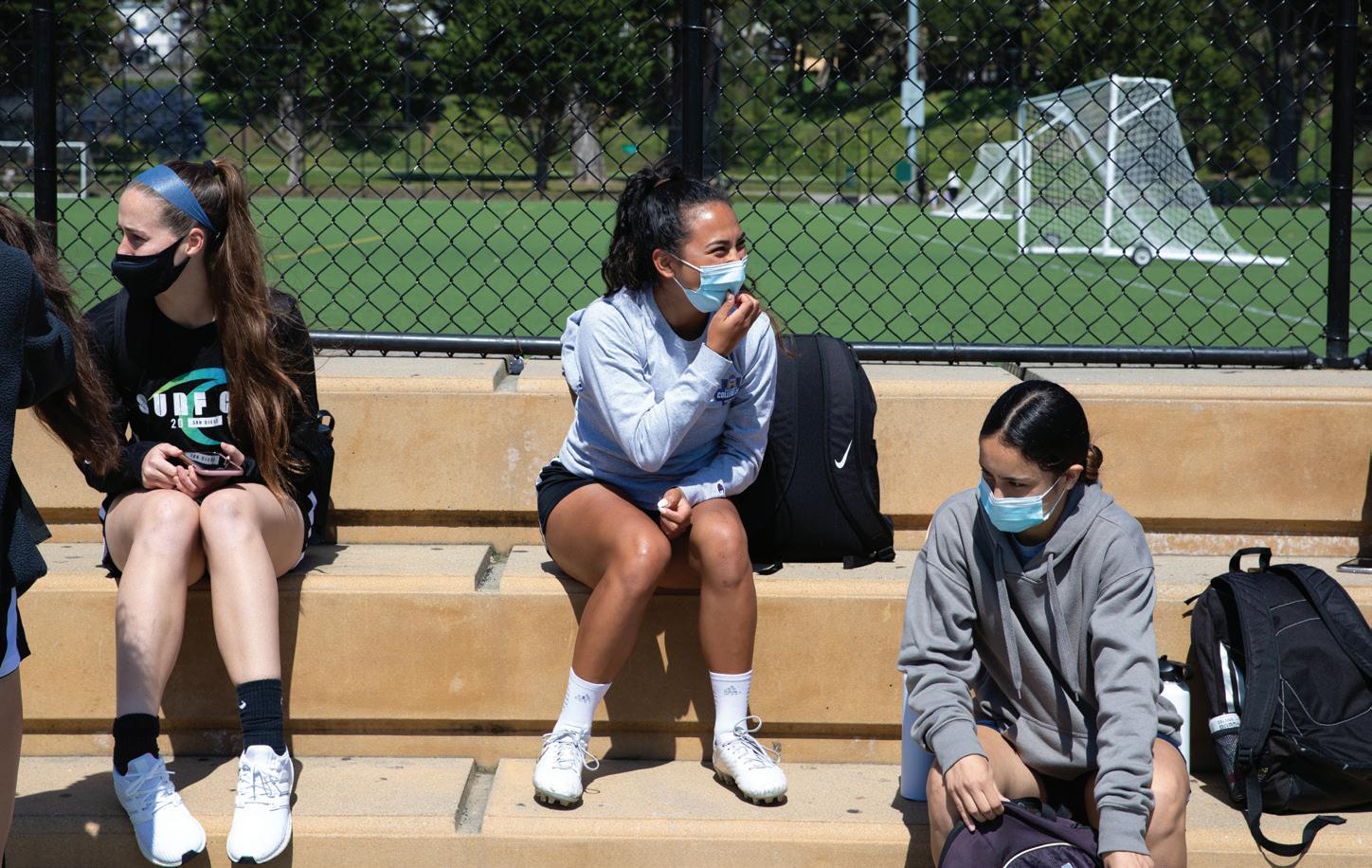
Aida Pedemonte chats and laughs with her teammates before they run drills and hold a scrimmage at the Crocker Amazon soccer fields during spring break this past semester.
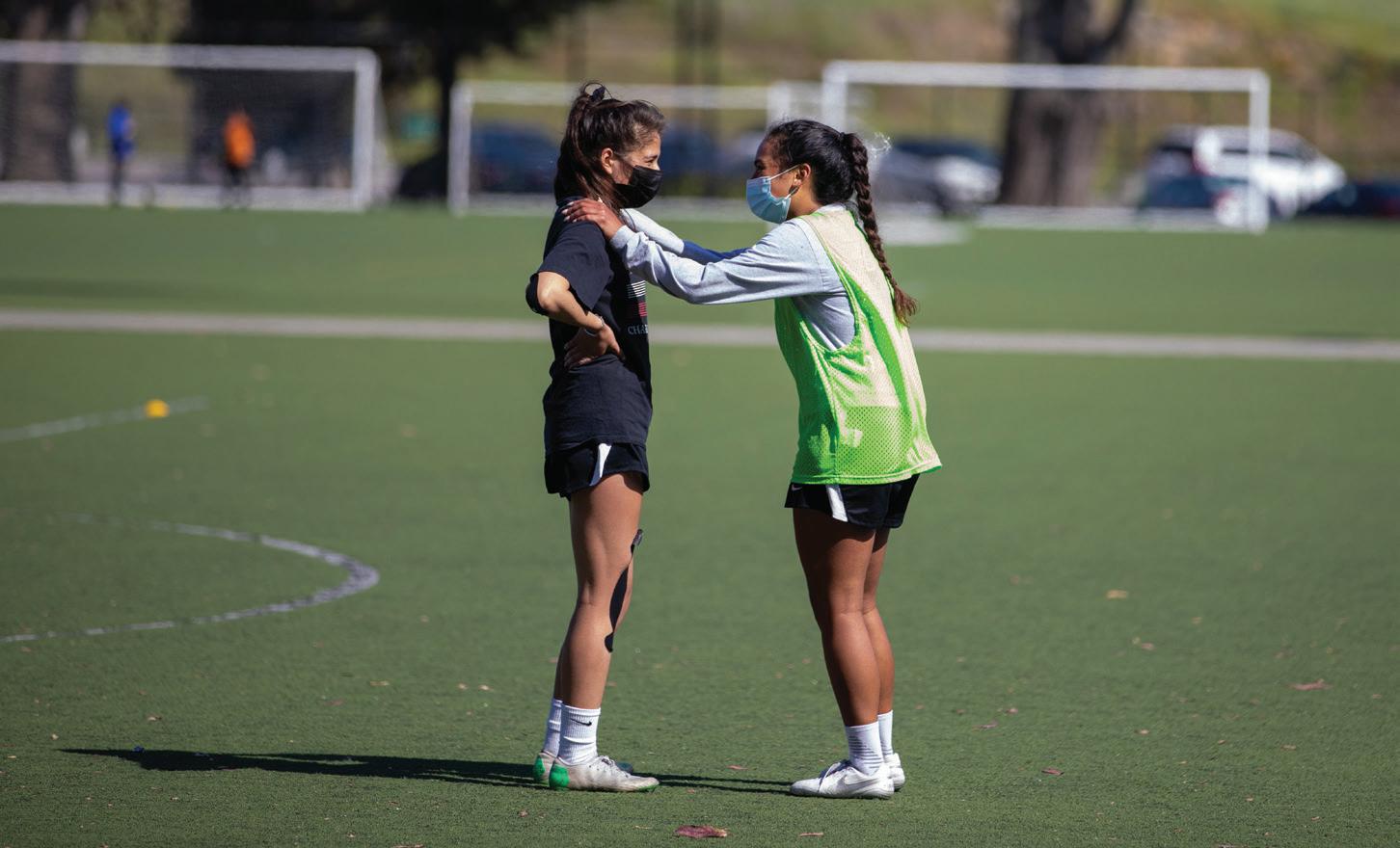

Above: Pedemonte fixes her hair while a teammate chats in her ear after practice. Below: Pedemonte, left, dribbles the ball while being guarded by Maleah Evans, right, who was working defense. total. The U.S. men’s national team has only placed once at the 1930 inaugural World Cup with a bronze medal victory. However, the 2019 U.S. women’s team earned $30 million in prize money compared to $400 million earned by the French men’s team at the 2018 men’s World Cup, according to The Wall Street Journal.
Back on the soccer field, Dydasco Pedemonte hounds each attacking forward that tries to advance. As an outside fullback, she guards the rear and shouts encouragement to her team’s forwards and strikers.
The melange of voices communicating passes and warnings persists as the game turns into a fierce dance. The teams trade victories, each getting one win. On the following Thursday, Dydasco Pedemonte and her team dominated the field and defeated the Vikings, the team they had practiced and scrimmaged for, ending the game three-nil.
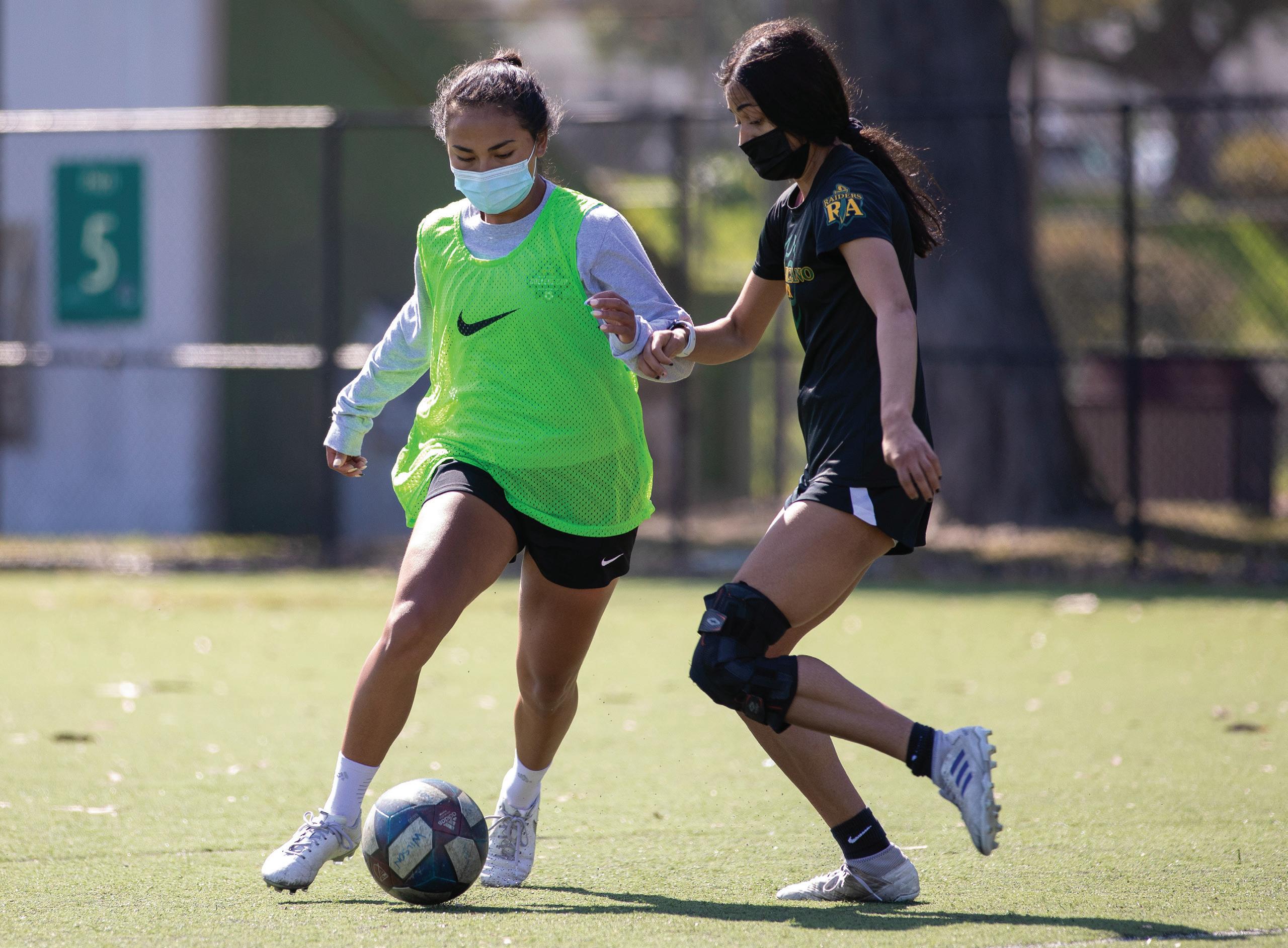
THROUGH HER EYES
María del Río, left, chats with her digital technician Victoria Manildi O’Brien, right, at her photo shoot for Haleys Beauty, a Bay Area based makeup company.
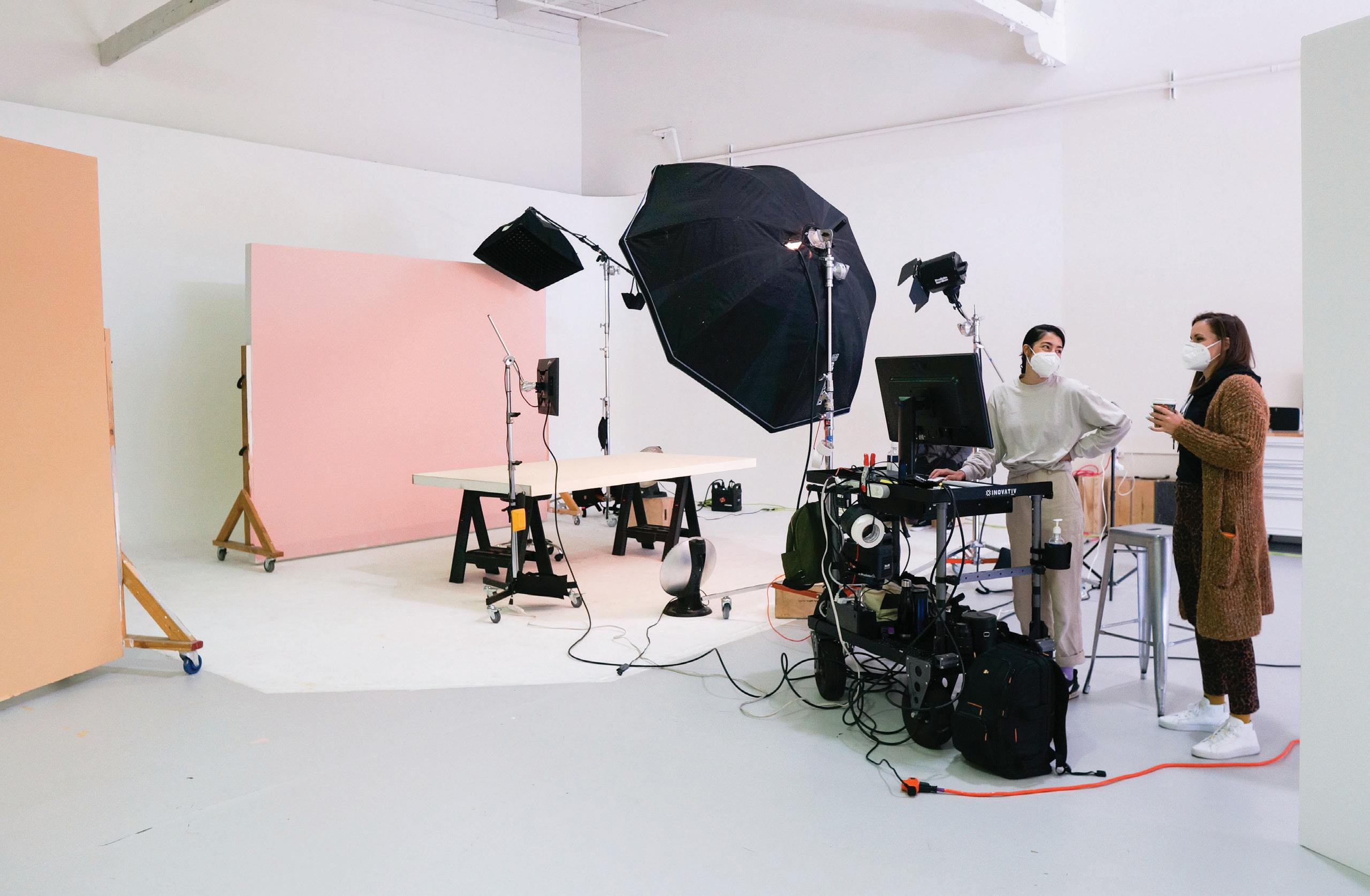
Del Río photographs a model during her photo shoot for Haleys Beauty.
Women of color diversify the workplace in front of and behind the camera
Story and photography by Xiaofan Fang
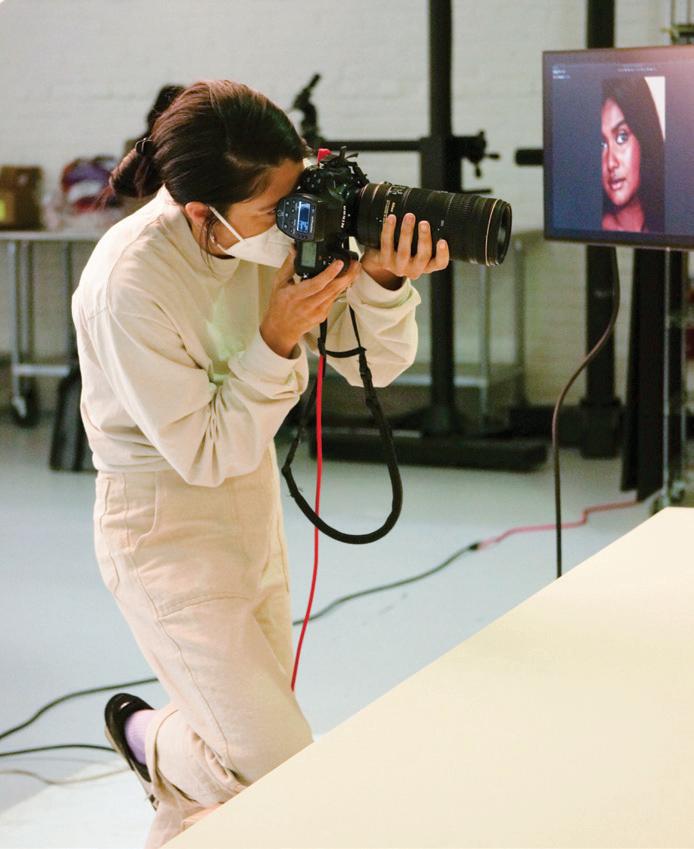
Latina photographer María del Río joined a pre-production meeting about an upcoming shoot. The client shared their lineup of eight models. “They were all blonde and blue-eyed without exception,” the former City College of San Francisco student and Oakland-based photographer recalled.
“I notice that all of the talent you suggested are white women, and I’m wondering if there is room to incorporate diversity,” del Río pointed out. The client seemed flustered and explained that it was not intentional. After some discussion they swapped in two models of color.
White faces had dominated for decades. According to a 2015 article in The Atlantic magazine titled “The Least Diverse Jobs in America,” the arts and entertainment industry was the third least diverse industry in the United States.
Early in her career, del Río would tell her agent, Katie Patterson, about the unsettling lack of diversity. Patterson was nervous that if del Río spoke up, she would lose clients. When she was offered jobs with non-diverse casting, Patterson would tell del Río to prepare to “have the talk.”
Things have changed since then. Diversity in photography is now a hot topic and racial inclusivity on the runway has trended upward too. According to the fashion industry website The Fashion Spot, only 18% of runway models were people of color in the spring 2015 season globally. By the fall 2020 season, 41% were models of color. Achenrin Madit, a woman of color
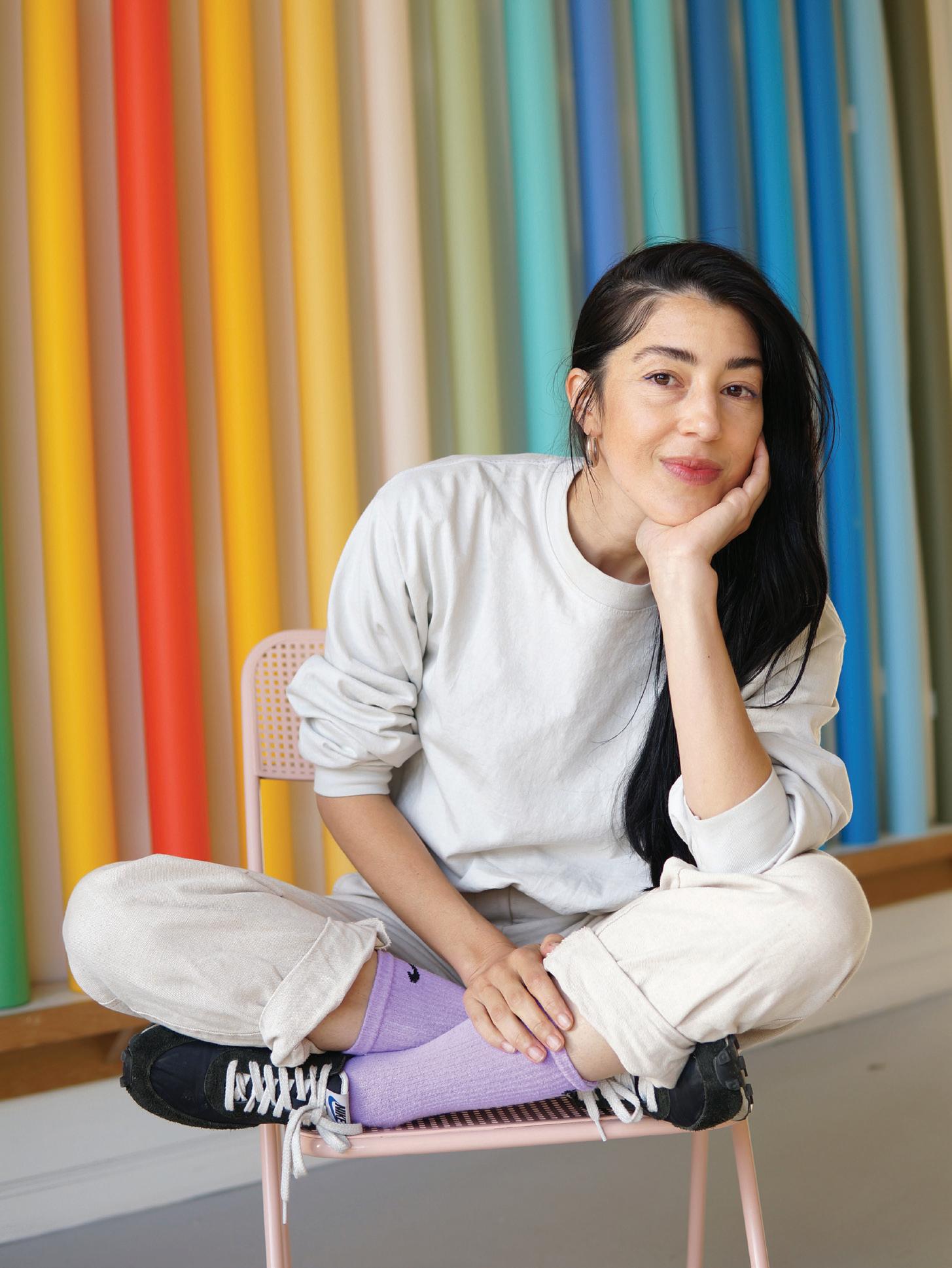
Photographer María del Río sits for a portrait while on set of her shoot for Haleys Beauty.
of South Sudanese descent, appeared in 38 shows and racked up more runway miles than any other model had that season.
“So much has changed,” del Río says. “Nowadays, clients come to me with all women models of color. There is no need for that awkward conversation... This change is so exciting and beautiful to see.”
On a recent ad campaign shoot, del Río was chatting with the art director, the prop stylist and the client — all of whom were white women. The art director commented, “It’s so beautiful that the ad campaigns are so diverse now. We’ve come so far with diversity!”
Del Río agreed. The client had indeed cast a wide range of models, diverse in age, race, and gender. However, out of the 12-person crew behind the camera, only two were people of color. “When you are a part of the minority, you notice this imbalance immediately,” del Río reflects.
According to the 2019 U.S. Census, 53% of professional photographers were male and 73% were white. Jung Fitzpatrick, a Korean-American photographer and former City College student, knows this from experience. Recently, while on set as a COVID-19 compliance officer, she noticed that the entire crew was white, except an assistant and herself. She was not surprised. “For most sets I’m on, I assume that it’s going to be mostly white people.”
In the film industry, “it’s even worse,” del Río says. 60% of professional directors were male and 76% were white according to the 2019 U.S. Census.
“In any category of directing, very few women had a chance,” says music video and advertising director Vanessa Beletic. As recently as four years ago, her female colleagues were rejected by production companies with blatant excuses like “We already had a woman on our roster” or “We don’t get the kind of work you are right for.”
“If a female director was fortunate enough to be signed,“ Beletic says, “she would get commercials for tampons, birth control, and maybe, makeup.” After directing officially for seven years and unofficially for 15, she was offered a sports
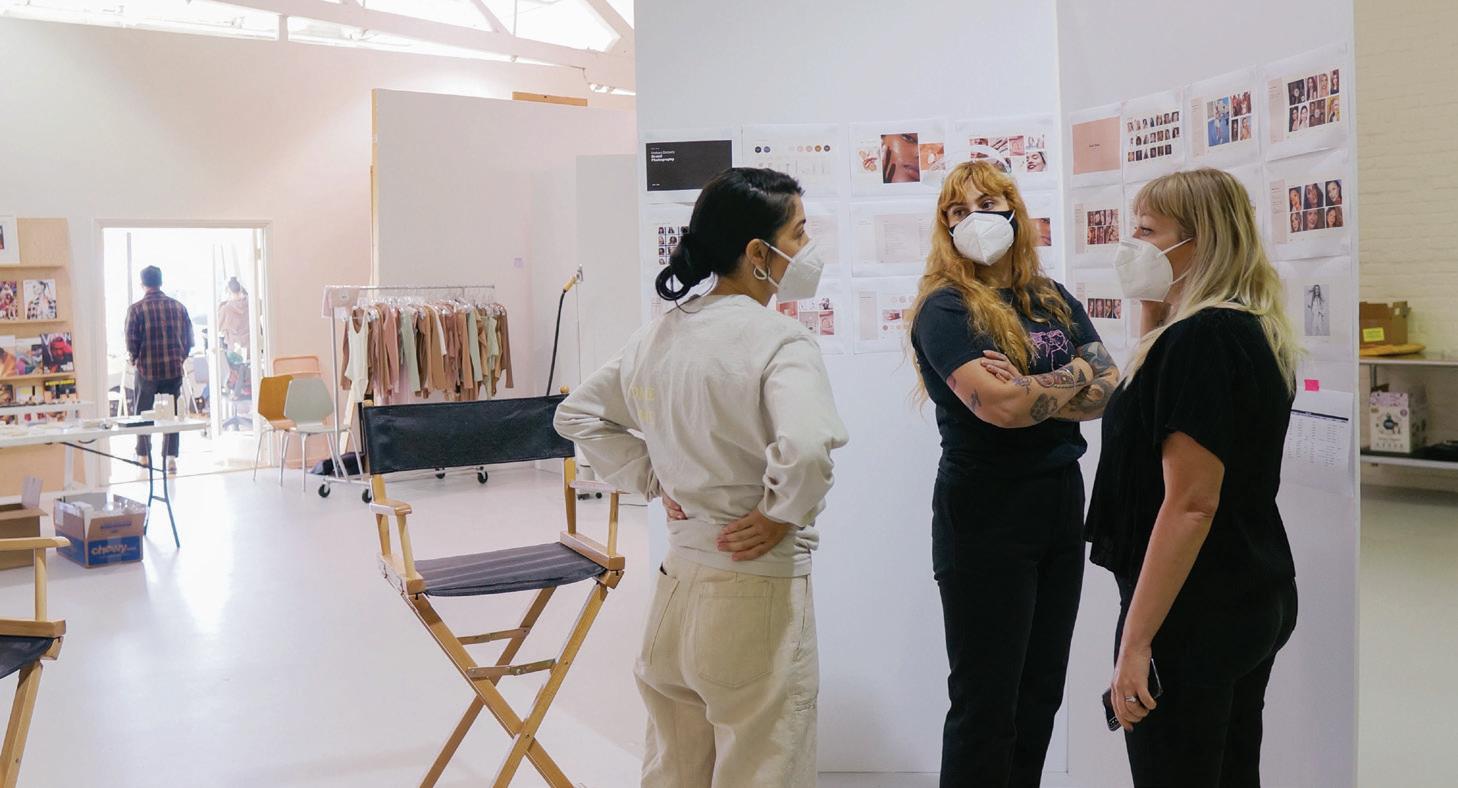
Del Río, left, discusses concepts with the hair stylist’s assistant Amber Jahn, center, and the art director Danielle Moore, right, at the photo shoot for Haleys Beauty.

drink commercial for the first time last year, an opportunity that she says is traditionally given to men.
Women make, on average, 79 cents for every dollar men earn. However, women of color face an even wider pay gap. Black
women earn 65 cents on the dollar, while Latinas earn a dismal 54 cents, according to a 2016 article in The Atlantic magazine.
“The threshold for diversity can still be about cisgender white women, rather than women of color, black women, and indigenous women. That doesn’t even include gender-expansive folks,” says Tanea Lunsford Lynx, women’s and gender studies instructor at City College.
There are few women of color in managerial positions within all fields and even fewer in executive roles. White men make up 35% of the entry-level roles and 44% of managerial positions according to the 2020 McKinsey Institute report on women in the workplace. While the percentage of white men in higher positions increases, the career trajectory for women of color is not promising. They only make up 18% of entry-level roles and 12% of managerial positions.
“When I look at production companies’ websites and rosters, all of the founders and executive producers are white and mostly white men,” Beletic says. She thinks they only hire people of color when they fear they might get audited.
“It’s frustrating that they think they have done their diversity duty,” Lynx says.
Having people of color in executive and hiring positions is crucial. “Whoever’s in power is going to open a door and give an opportunity to others. It’s my chance to give a chance to women and people of color and hire them as my key collaborators,” Beletic says.
Without women of color in higher positions, there are also fewer role models. While taking a photography course at
her local community college in Santa Fe Resources are now beginning to surface Recently, del Río was hired to during high school, del Río was to help women and people of color break photograph an intimate campaign discouraged because “there wasn’t a into the photography industry. “One that about female empowerment. One of single person of color in that class.” She I really love is Authority Collective,” del the models, a breast cancer survivor, distinctly remembers thinking, “This art Río says. Authority Collective, founded would be photographed topless. Del Río form is not for me.” in 2017, “works to empower marginalized felt it was important to hire an
Del Río did not pursue artists with resources and all-women and racially diverse crew. photography again until she was community, and to take action against Given the status quo of the industry, studying Latin American sourcing a and Latino Studies a few years later. “I was able to learn more about and take “Someone in disadvantage brings a certain level of awareness that a privileged person may not have.” diverse crew was far from an easy task. pride in my identity.” She signed up for — María del Río After many months of another photography class. searching, “It became exciting and attainable again.” systemic and individual abuses” she helped to hire 40 women, including
Del Río faced an economic barrier when according to their website. the director of photography and all of the she first started out. “I had to be able to “Out of all the organizations that I’m technicians. 65% of the crew and talent afford a camera, lenses, film, processing part of or used for hiring, they are doing were women of color. fees, and access to the dark room. My it right,” del Río says. “They are really “The more perspectives there are, the mom saved up to buy a used camera for working to get their members hired and more truth there is in the images and the me and it didn’t work,” she says. “The into hiring positions.” Through Authority storytelling” del Río says. “Someone reality is that you’re buying subpar Collective’s well-connected network, del (at a) disadvantage brings a certain level equipment. You’re starting with a Río has received both scholarships and of awareness that a privileged person roadblock already.” actual jobs. may not have.”
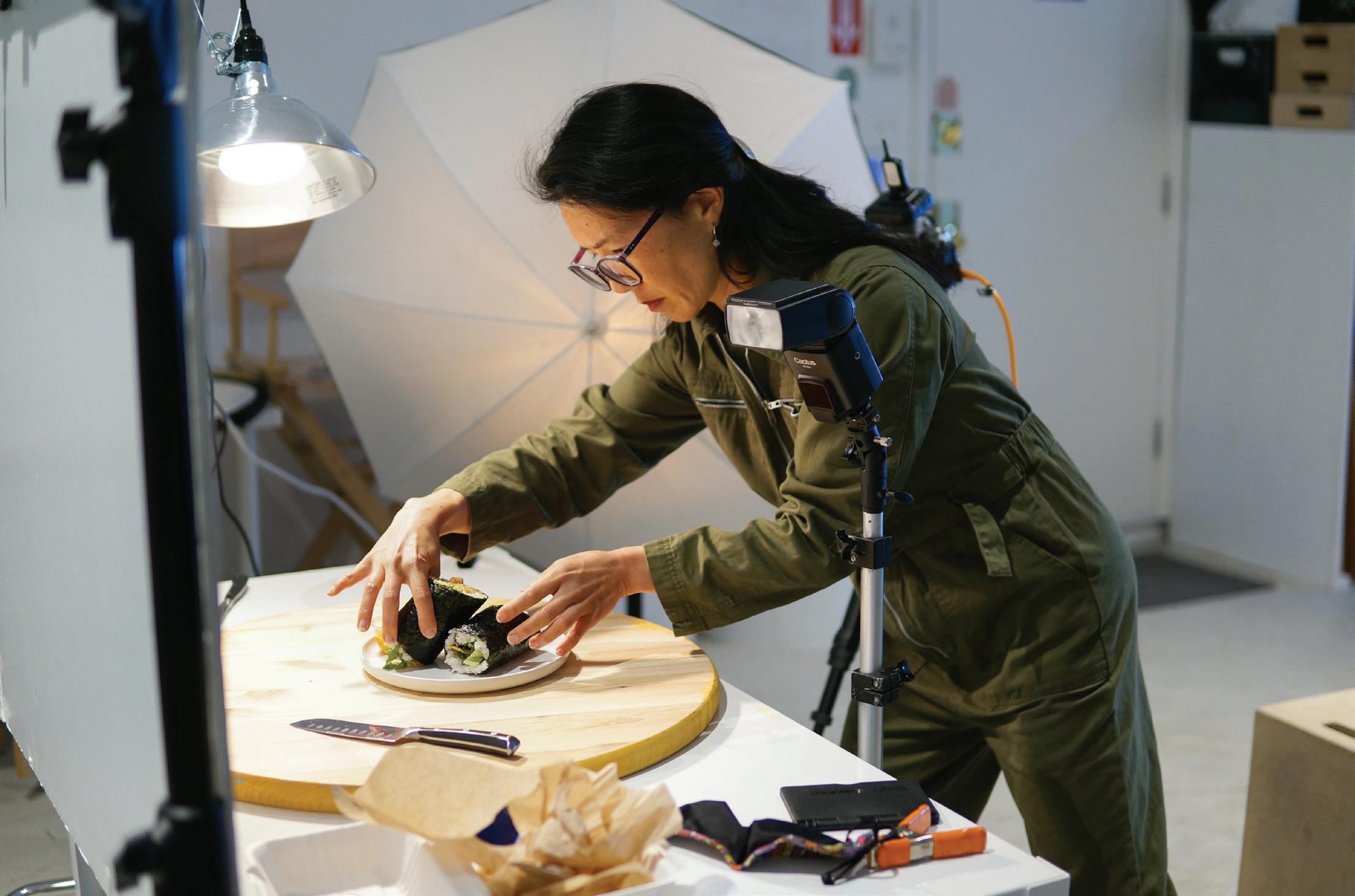
Beletic and Jung pay it forward through mentoring and helping women and people of color. Jung promotes her first workshop “The ABCs of photo assisting” in groups for women and diverse photographers. “Being my own boss, I get to create this world and culture for my business, which is really exciting,” she says.
Beletic mentors black women who want to become directors. “I want to support the folks that feel like they have the least chance. It has been really wonderful. … They all feel like they are leveling up,” Beletic says.
Del Río is busy shooting on set for a women-founded beauty brand. She clicks the shutter a few more times. “We got the shot, thank you,” she says to the red-haired model holding a light-shade foundation product up to her fair cheeks.
She gestures to the next model to sit down. Fourteen models, each

Fitzpatrick adjusts lighting equipment during a test shoot in her SOMA studio.
with different skin tones, arrive on set throughout the day. Del Río steps away from the camera and joins the art director and digital technician to inspect the images on the monitor. Although the crew is mainly women, few of them are women of color.
After last summer’s protests in the wake of George Floyd’s murder, the conversation about diversity resurfaced in the mainstream media. “Being a woman of color is a trend now,” Beletic says.
However, being trendy is by definition ephemeral. “We need to have patience,” she says. “A lot of people feel that there’s an over-correction. I 100% welcome the over-correction.” She believes that the best talent will rise to the top.
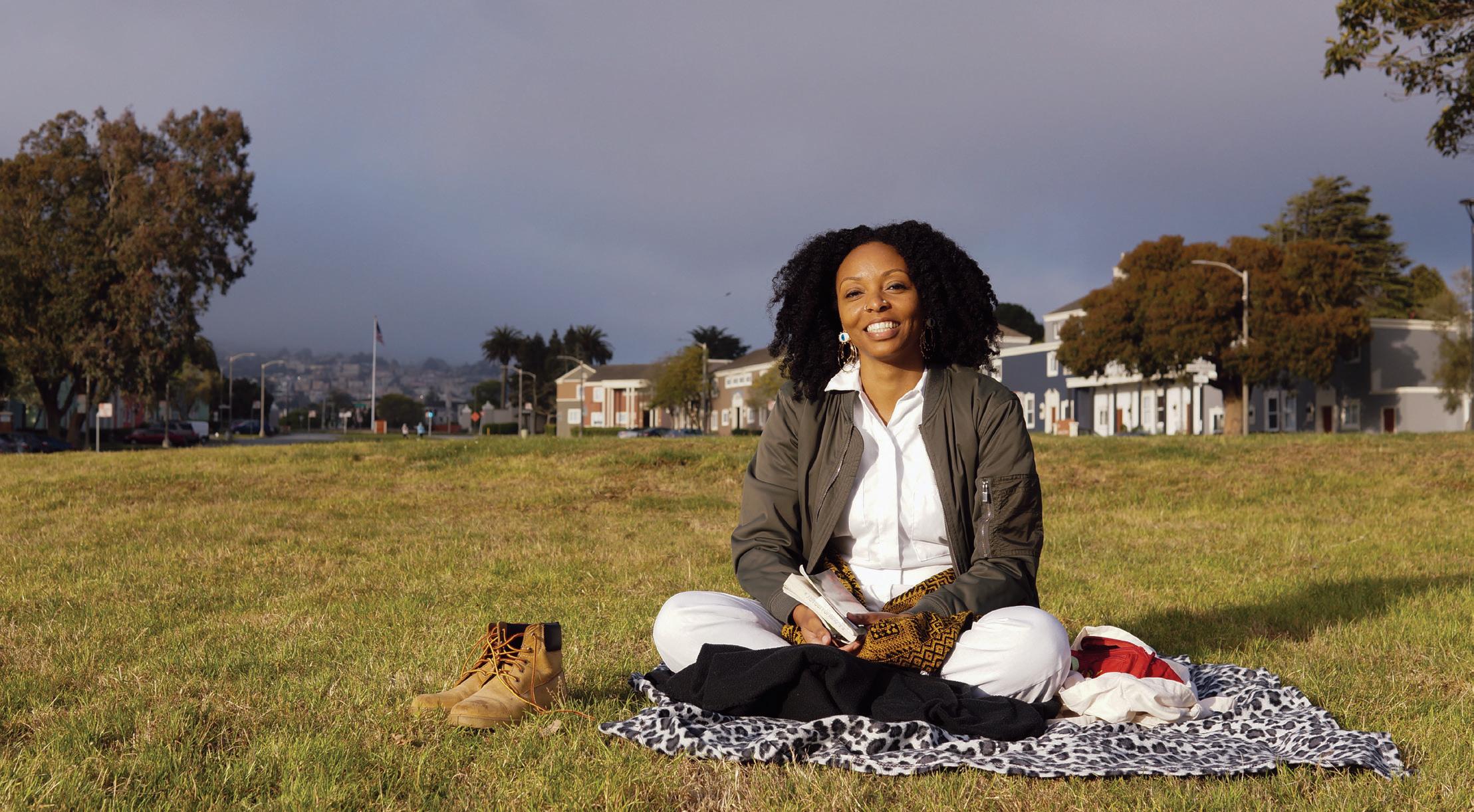
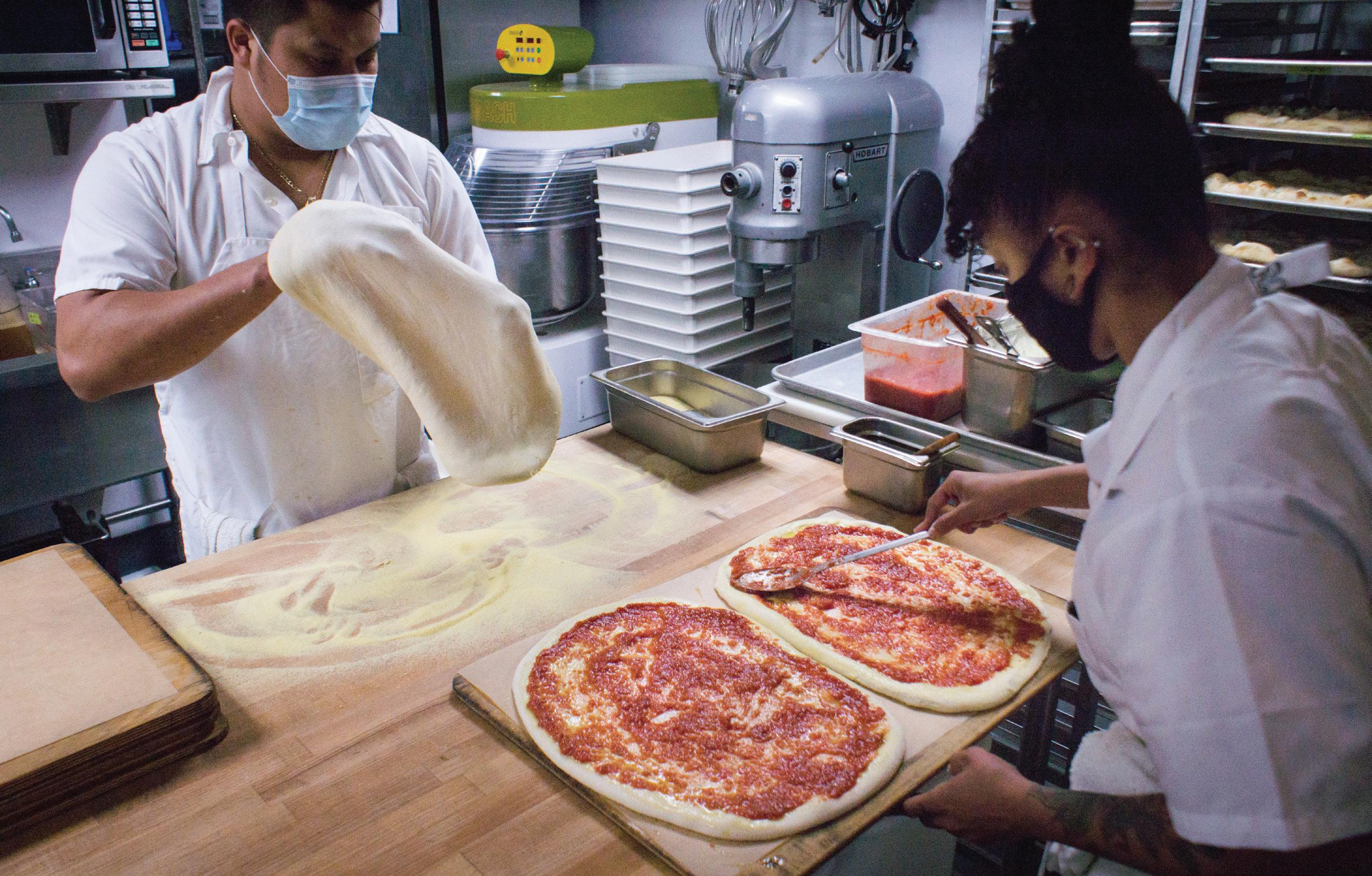
In Che Fico Alimentari’s back kitchen, sous chef Alexis Hernandez, left, stretches house-made pizza dough while Jazmine Fenton, right, spreads sauce.
Chefs adapt to survive changes in the
service industry Story by Megan Ogle Photography by Bo Lenschau Illustration by Bobby Ramirez

The clock strikes five as guests begin to arrive at Che Fico Alimentari. They check in with the host who stands outside prepared to discuss all of the COVID-19 rules while simultaneously taking to-go orders. Then the guests are seated at one of six tables in the wooden parklet strung with cafe lights on Divisadero Street. Suddenly the kitchen is in full swing.
Alimentari barely resembles its pre-pandemic self. Before COVID-19, Alimentari’s sister restaurant, Che Fico, was a popular restaurant with a long line of people waiting outside for a table. A year after Che Fico’s inception and just one year prior to the pandemic, owners Matt Brewer and David Nayfeld, opened their second restaurant, Che Fico Alimentari, downstairs. While Che Fico was a fine dining experience with a Californiainspired Italian menu, Alimentari was a smaller, casual eatery by comparison.
Before the pandemic, both restaurants combined would serve close to 500 guests in a night. When the pandemic hit, the owners folded both places into one operation, furloughed 90% of their employees and began serving out of Alimentari only.
With COVID-19 guidelines and regulations constantly changing, restaurants like Alimentari have had to make operational decisions on the fly, with little or no notice.
Many establishments closed their doors permanently as the pandemic dragged on. An estimated 30% of San Francisco neighborhood restaurants shuttered with no plans to reopen according to an article

published in SFgate in January 2021. The list of closures is expansive and includes landmarks like the historic Cliff House and Louis’ and neighborhood staples like Ton Kiang and Muddy Waters Coffee House, where over the past ten years Etc Magazine staff have met to edit stories over coffee and pastries. 5.9 million restaurant industry workers in the U.S. lost their jobs due to the pandemic according to an article published in May 2020 on Eater.com. This percentage does not even include employees who were not on payroll, like many undocumented workers.
The few employees that continued working were considered to be at a very high risk of contracting and dying from COVID-19, according to a University of California, San Francisco study. The study found that kitchen staff, and more specifically, line cooks were at the highest risk.
In spite of this, a handful of cooks and chefs stayed on at Alimentari to help keep its doors open, food on the table and money in their pockets.
Jazmine Fenton, sous chef at Alimentari, never stopped working. “I have definitely had to take on a lot more responsibility...and be able to pivot and change at any moment.”
The switch from fine dining to take-out and to-go is not an easy conversion, impacting everything from menu-item options to workflow management.
When Alimentari first reopened with a pared down kitchen staff they tried to do the full menu as take-out only, but after a week, abandoned that plan.
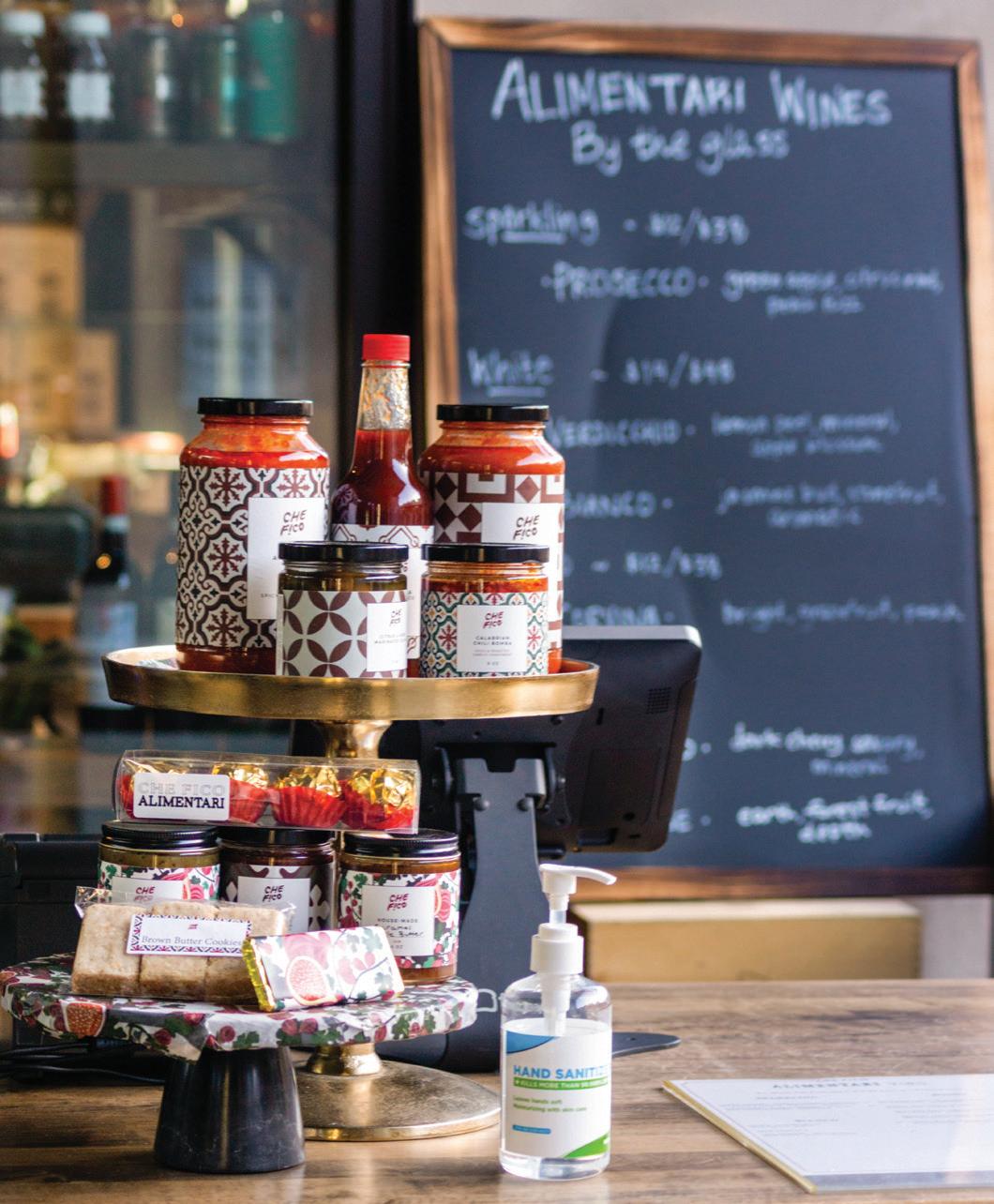
Alimentari sells their own Italian-inspired pantry products including sauces, pastas, cocktails and deserts to generate another stream of income.
In the small kitchen of Birba wine bar, Intu-On Kornnawong creates what she calls “Thai drinking food” to serve at her pop-up restaurant. Birba wine bar hosts Kornnawong’s eponymous pop-up on Sundays. Her cuisine goes well with the variety of fine wines and spirits that Birba offers.
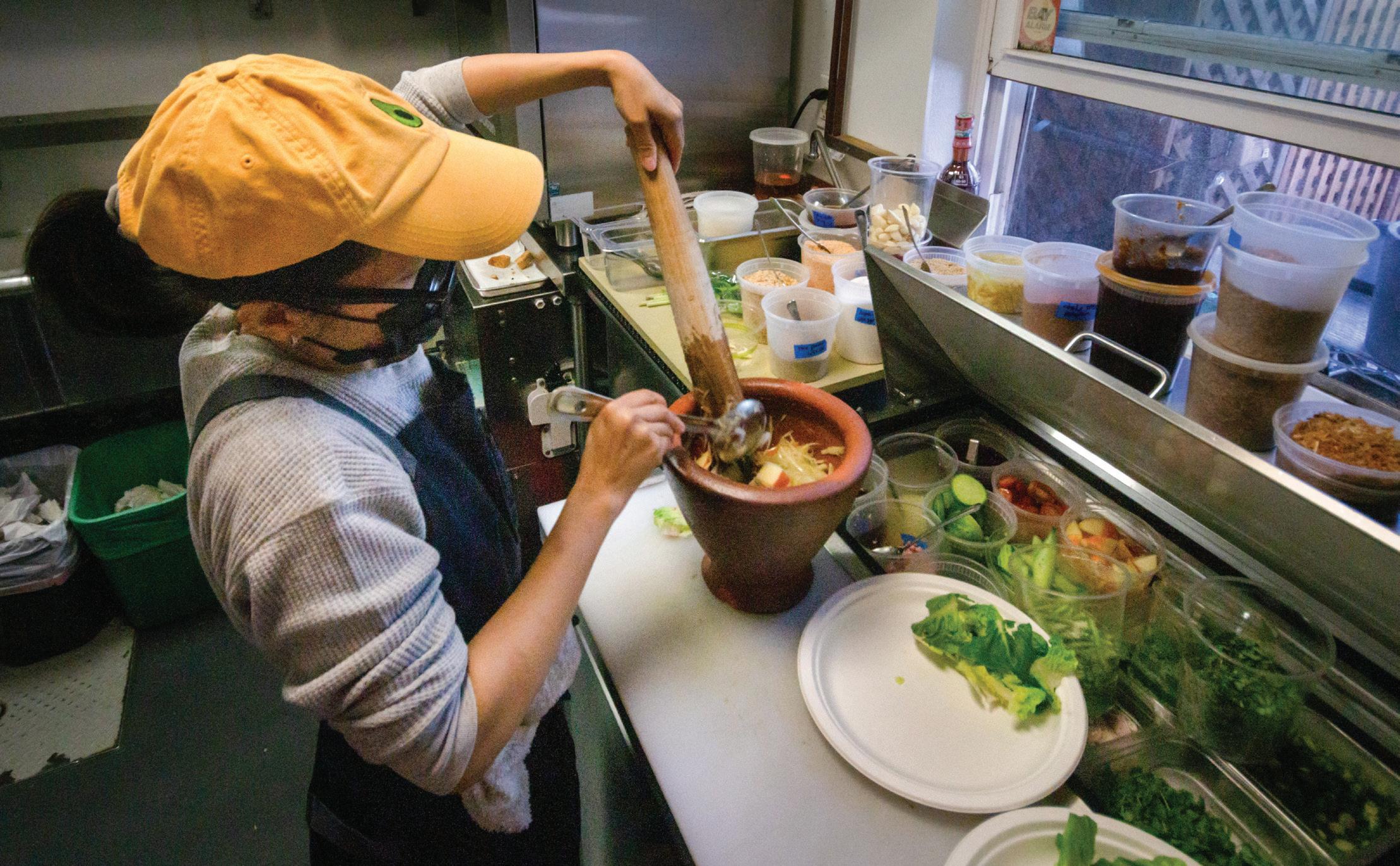
They began a meal donation program offering free meals to anyone in need. It was sponsored by large donations from wealthy patrons. They called this the Family Meal Menu. After about a month, paying customers could order off the Family Meal Menu too.
They were preparing up to 300 meals a day, each feeding two to three people. Alementari Sous Chef and City College alum, JD Herrera, was back in high-volume cooking. “You have to think about logistics a lot differently,” he says.
In August, the Bay Area was coming out of its second COVID-19 surge, and Alimentari switched back to a traditional to-go and take-out format again but with a pared down menu. They built their parklet.
Nobody sits at the chef’s counter anymore to watch the three cooks prepare meals in the open kitchen. Employees use the space to jar and label pantry items for shipment and package to-go orders for delivery. As of April 2021, there are still no indoor diners.
Sous chef Fenton says there is a big difference between preparing in-person dining meals and to-go boxes. “The nature of to-go food is thinking about how these dishes are going to travel,” she says.
The chefs at Alimentari package the food in compostable boxes, each suitable for the dish that is being delivered. Each box is taped shut so nothing spills en route and to show that the food has not been tampered with.
For in-person dining, preparation is very much about presentation because the guest is right there. “The experience is sensory,” Fenton says.
“One of the things that really set us apart, in addition to our food being good, was the atmosphere that we created here,” Hererra says.
“I just don’t think people think about the cogs of the machine, or how many people it takes to make their experience possible,” Fenton says.
If things are not complicated enough, Alimentari now sells pantry products too. Sauces, pastas, cocktails, salamis and even desserts have all been canned, jarred, packaged and labeled by hand. They offer holiday meals and community-supported agriculture boxes that consist of a combination of produce from Bay Area farmers and Alimentari pantry items. This is all while operating with only 10% of their pre-pandemic staff.
Intu-On Kornnawong was laid off in March as sous chef at Kin Kao, a Thai restaurant in the Dogpatch neighborhood. Now she runs her own pop-up and does consulting.
At first the change was upsetting and stressful, but it allowed her the space to focus on her own projects. Before the pandemic, she was reluctant to start her own business, but she was pushed out of her comfort zone and forced to take a leap of faith. “Before I was thinking, ‘Ok, I don’t have money so I need to be at the restaurant, and I need more experience,’” she says.
Intu-On is her eponymous Thai pop-up that takes place at Birba wine bar and retail shop in Hayes Valley every Sunday. Like Alimentari, Birba has a parklet in front. There is also a heated back patio with tables spread safely apart.
Kornnawong creates North-Eastern “Thai drinking food” with California ingredients. She does not play it safe. The food is spicy and acidic and definitely much different than other Thai food found around the city.
“I like to be creating things all the time and COVID pushed me to get out and do something new,” Kornnawong says. She had done pop-ups around the city previously and decided to start again, this time designing her menu to go well with beer and wine. Birba was a perfect match. The wine bar was serving small bites before Intu’s pop-up, but her menu significantly increased their business.

Allison Schaffer, left, hands an order to customer Sitara Gurung, right. A newly built mobile counter by Alimetari’s entrance functions as a space for staff to safely interact with customers.
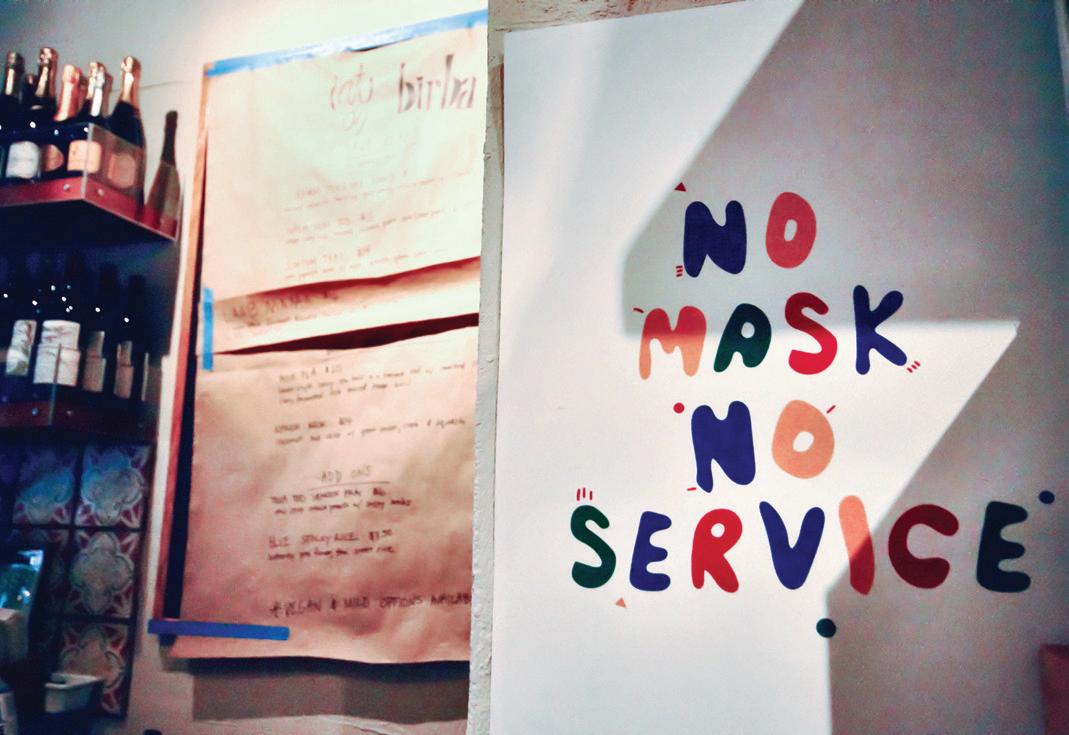
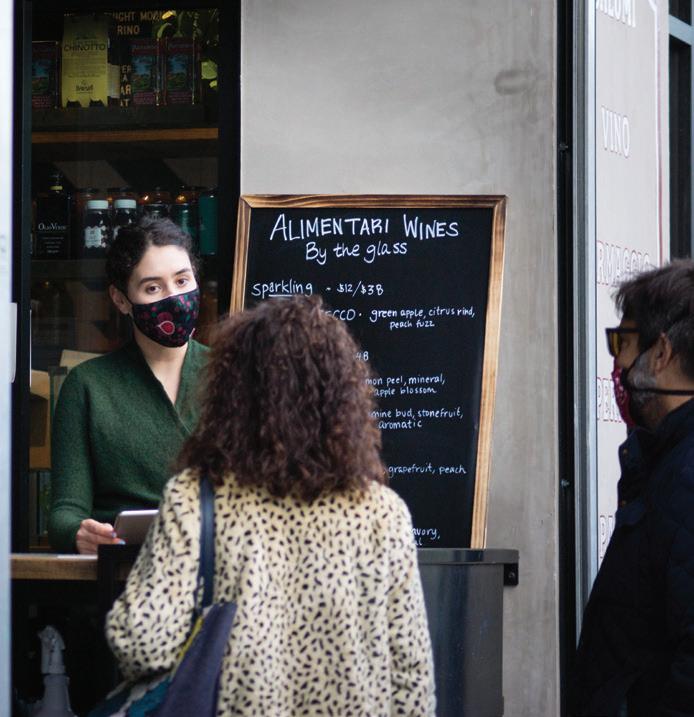
Allison Schaffer, left, takes a to-go order from two customers at Alimentari.
Alimentari’s kitchen spans nearly the entire width of the restaurant, allowing staff members to work side-by-side. The open-concept enables restaurant guests to watch the action while sitting inside, but Alimentari was closed to indoor dining for quite some time.
Erik Harrelson decided on a more extreme career change when he lost his job. He had been head chef at both Radhaus and at Biergarten, German style eateries in Fort Mason and Hayes Valley. He went on to work as a private chef for a wealthy Bay Area family.
When he first lost his job, it did not feel permanent. But as one month became two and so on, he eventually came to terms with the idea that he might not be going back to work for a while.
The pandemic provided Harrelson with the first long-term break of his 23-year career. “Having that much time off made me reevaluate.” He wondered how much of his identity was wrapped up in his job.
While he liked the camaraderie and energy of a restaurant, he did not like the long hours and unspoken expectation of unpaid overtime. He saw three options: Go back to the restaurant when it opens up again, look for a culinary director position which would provide a better work-life balance or go the private chef route. He decided to go with option three. Through a friend he was introduced to a San Francisco family who hired Harrelson to cook for them.
The family is based in San Francisco but decided to move to Hawaii for a few months late in the pandemic. They took Harrelson with them. He did all of the family’s cooking and all of the household shopping.
Cooking privately is a “very different beast,” he says. It required a change in his thought process: There is no set menu. He admits that there was a learning curve. He went from leading a group of forty-plus people to being a one-person team.
Working as a private chef provided Harrelson with a steady income, a stint in Hawaii, and more freedom in his schedule, but there was limited upward mobility. “In a restaurant, the harder you work the more money you make,” he says. However, Harrelson does not see himself going back to work in another chef’s kitchen anytime soon. “Killing myself to put money in someone else’s pocket sounds awful,” he says.
Harrelson, recently let go of his private chef job, is back in the Bay Area looking for what’s next. He started a meal-kit delivery company while in Hawaii and plans to split his time between both places. While he is unsure what the future holds, he is focused on his company in hopes that it takes off. No matter what happens, “I still love to cook,” Harrelson says.
Kornnawong plans to continue with her Sunday pop-up at Birba and hopes to one day own her own restaurant.
By the time this article is published, Alimentari anticipates that they will be serving about 100 diners on-site per night. Fenton is prepared. “We have learned so much about our capabilities that we have the ability in the future to make an even better restaurant than we already have.”
